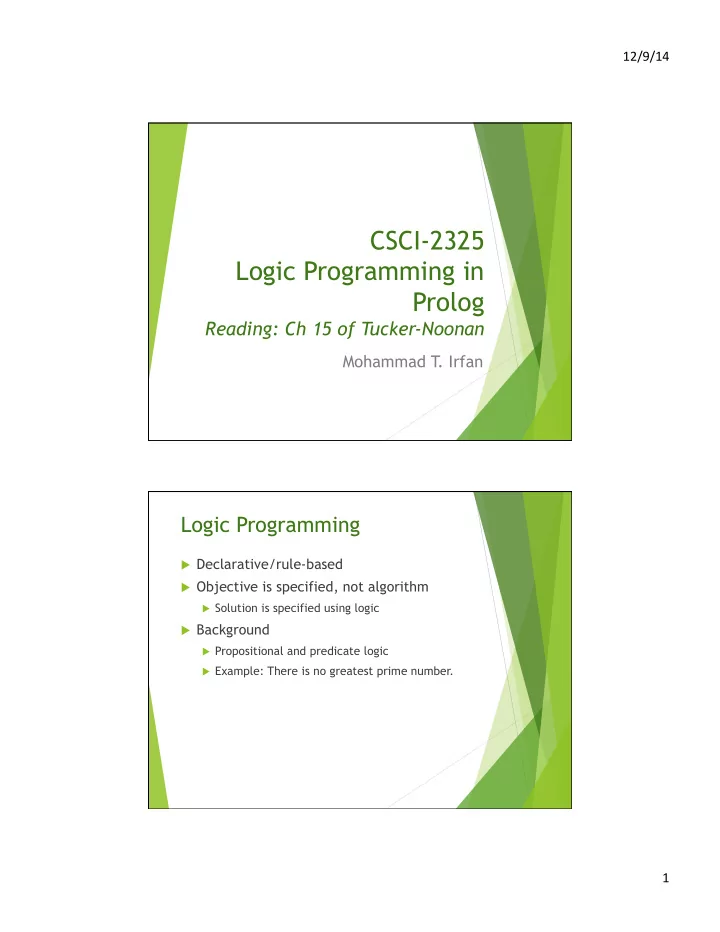

12/9/14 ¡ CSCI-2325 Logic Programming in Prolog Reading: Ch 15 of Tucker-Noonan Mohammad T . Irfan Logic Programming u Declarative/rule-based u Objective is specified, not algorithm u Solution is specified using logic u Background u Propositional and predicate logic u Example: There is no greatest prime number. 1 ¡
12/9/14 ¡ Horn clause u Special type of predicate logic u p 1 Λ p 2 Λ ... Λ p n => h u To show h, first show p1, then p2, ..., pn u Notation: h ç p 1 , p 2 , ..., p n u Equivalent to: (p 1 Λ p 2 Λ ... Λ p n ) V h u Equivalent to: p 1 V ... V p n V h u Not all predicates can be written as Horn clause u Every literate person can read or write Resolution u Making inference from several clauses u Example (Wikipedia) u All Greeks are Europeans. Homer is a Greek. Therefore, Homer is a European. u Therefore, u Another example , L), X ≠ Y u talksWith(X, Y) ç speaks(X, L), speaks(Y speaks(Alice, French) speaks(Bob, French) Instantiation u Therefore, talksWith(Alice, Bob) 2 ¡
12/9/14 ¡ Unification u How to do the instantiations? u One solution: recursively find all possible instantiations for which resolutions can be made Prolog Colmerauer, Rousseau, Kowalski (1970) 3 ¡
12/9/14 ¡ Resources u Installation u http://www.swi-prolog.org/Download.html u Learning u John Fisher’s problem-centric tutorial u http://www.csupomona.edu/~jrfisher/www/ prolog_tutorial/contents.html Syntax u Terms u Constants u ‘Alice’, english, zebra u Variables u Person, Language u Structures u Predicate (with possible arguments) u speaks(Person, Language) u Rules u Horn clauses: term :- term_1, term_2, ..., term_n u Facts u Horn clauses with empty head/goal 4 ¡
12/9/14 ¡ Example: “talk.pl” u Program in talk.pl file speaks(alice, french). speaks(bob, french). speaks(clive, english). speaks(doug, french). talksWith(X,Y) :- speaks(X, L), speaks(Y, L), X \= Y. u consult(talk). u talksWith(alice, bob). u talksWith(alice, clive). u talksWith(P , bob). u listing(speaks ). Closed-world assumption u Just because Prolog cannot prove something, it will say it’s false u true/fail system, not true/false 5 ¡
12/9/14 ¡ Example: family tree grandparent(G,X) :- parent(P,X), parent(G,P). sibling(X,Y) :- parent(P, X), parent(P, Y), X \= Y. parent('Alice', 'Bob'). parent('Clive', 'Bob'). parent('Doug', 'Alice'). parent('Clive', 'Eric'). u grandparent(G, ‘Bob’). u sibling(S, ‘Bob’). Trace factorial(0, 1). Force factorial(N, Result) :- instantiation N > 0, M is N-1, factorial(M, SubResult), Result is N * SubResult. u trace . %Enter trace mode. To exit: notrace u factorial(4, X). 6 ¡
12/9/14 ¡ Eight queens problem valid (TrialRow, TrialDiag1, TrialDiag2, RowList, Diag1List, Diag2List) :- not(member(TrialRow, RowList)), not(member(TrialDiag1, Diag1List)), not(member(TrialDiag2, Diag2List)). getDiag (Row, Col, Diag1, Diag2) :- Diag1 is Row + Col, Diag2 is Row - Col. place (N, Row, Col, RowList, Diag1List, Diag2List, Row) :- Row < N, getDiag(Row, Col, Diag1, Diag2), valid(Row, Diag1, Diag2, RowList, Diag1List, Diag2List). place (N, Row, Col, RowList, Diag1List, Diag2List, Answer) :- NextRow is Row + 1, NextRow < N, place(N, NextRow, Col, RowList, Diag1List, Diag2List, Answer). 7 ¡
12/9/14 ¡ solve (N, Col, RowList, _, _, RowList) :- Col >= N. solve (N, Col, RowList, Diag1List, Diag2List, Answer) :- Col < N, place(N, 0, Col, RowList, Diag1List, Diag2List, Row), getDiag(Row, Col, Diag1, Diag2), NextCol is Col + 1, solve(N, NextCol, [Row | RowList], [Diag1 | Diag1List], [Diag2 | Diag2List], Answer). queens (N, Answer) :- solve(N, 0, [], [], [], Answer). 8 ¡
Recommend
More recommend